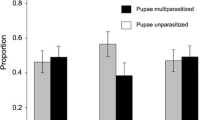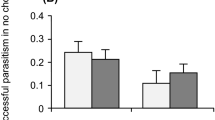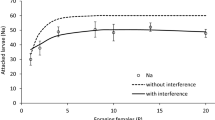Abstract
Three hymenopteran parasitoids that attackPlathypena scabra (F.) larvae often oviposit into consecutive instars of the host. We investigated host discrimination by adults and competitive interactions among larvae of these three parasitoid species. Avoidance of superparasitism byCotesia marginiventris (Cresson) andDiolcogaster facetosa Ashmead was tested. Females of each species were presented either withP. scabra parasitized by a different female of the same species 6 h earlier or unparasitizedP. scabra. Under these conditions,C. marginiventris attacked similar numbers of parasitized and unparasitized hosts.D. facetosa attacked 31% fewer parasitized than unparasitizedP. scabra. The avoidance of multiple parasitism byD. facetosa was studied in a similar bioassay. AlthoughD. facetosa females parasitized fewerP. scabra that had been attacked byC. marginiventris 6 h previously, the reduction in parasitism was only about 23%. In competition studies, immatureD. facetosa were better competitors than immatureC. marginiventris. Aleiodes (=Rogas) nolophanae (Ashmead) was an inferior competitor against bothC. marginiventris andD. facetosa when the duration between parasitism events was 1 h, but their competitive ability increased when they multiply parasitized hosts at least 32 h after the initial oviposition.
Résumé
Les larves dePlathypena scabra (Lep.: Noctuidae) sont parasitées par trois espèces d'Hyménoptères parasitoïdes qui pondent souvent dans trois stades larvaires consécutifs de l'hôte. Nous avons étudié le choix de l'hôte par les adultes et les relations de compétition entre les larves de ces trois parasitoïdes. La faculté d'éviter le superparasitisme a été étudiée chezCotesia marginiventris (Cresson) etDiolcogaster facetosa Ashmead. Des larves deP. scabra parasitées 6 h plus tôt par une autre femelle de la même espèce ou des larves non parasitées ont été offertes à des femelles de ces deux espèces de parasitoïdes. Dans ces conditions,C. marginiventris attaque un nombre semblable deP. scabra parasités et non parasités alors queD. facetosa attaque 31% de moins deP. scabra parasitées que non parasitées. La faculté d'éviter le multiparasitisme a également été étudiée chezD. facetosa dans une expérience similaire. Bien que les femelles deD. facetosa parasitent moins deP. scabra attaquées 6 h plus tôt parC. marginiventris, la réduction du parasitisme était seulement d'environ 23%. Dans les situations de compétition, les larves deD. facetosa l'emportaient sur celles deC. marginiventris. Aleiodes (=Rogas) nolophanae (Ashmead) était éliminé lorsque les larves de cette espèce étaient mises en compétition avecC. marginiventris ou avecD. facetosa si le délai entre les 2 ovipositions était inférieur à une heure, mais leur degré de compétitivité augmentait lorsque le délai était supérieur à 32 h après l'oviposition initiale.
Similar content being viewed by others
References
Bakker, K., Eijsackers, H. P. J., Van Lenteren, J. C. &Meelis, E. — 1972. Some models describing the distribution of eggs of the parasitePseudeucoila bochei (Hym. Cynip.) over its hosts, larvae ofDrosophila melanogaster. —Oecologia (Berl.), 10, 29–57.
Bakker, K., Van Alphen, J. J. M., Van Batenburg, F. D. H., Van der Hoeven, N., Nell, H. W., Van Strien-Van Liempt, W. T. F. H. &Turlings, T. C. J. — 1985. The function of host discrimination and superparasitization in parasitoids. —Oecologia, 67, 572–576.
Braman, S. K. &Yeargan, K. V. — 1991. Reproductive strategies of primary parasitoids of the green cioverworm (Lepidoptera: Noctuidae). —Environ. Entomol., 20, 349–353.
Browning, H. W. &Oatman, E. R. — 1984. Intra- and interspecific relationships among some parasites ofTrichoplusia ni (Lepidoptera: Noctuidae). —Environ. Entomol., 13, 551–556.
Eller, F. J., Tumlinson, J. H. &Lewis, W. J. — 1990. Intraspecific competition inMicroplitis croceipes (Hymenoptera: Braconidae), a parasitoid ofHeliothis species (Lepidoptera: Noctuidae). —Ann. Entomol. Soc. Am., 83, 504–508.
Force, D. C. — 1970. Competition among four hymenopterous parasites of an endemic insect host. —Ann. Entomol. Soc. Am., 63, 1675–1688.
Greany, P. — 1986.In vitro culture of hymenopteran parasitoids. —J. Insect Physiol., 32, 409–419.
Guillot, F. S. &Vinson, S. B. — 1972. Sources of substances which elicit a behavioural response from the insect parasitoid,Campoletis perdistinctus. —Nature, 235, 169–170.
Hammond, R. B., Poston, F. L. &Pedigo, L. P. — 1979. Growth of the green cloverworm and a thermal-unit system for development. —Environ. Entomol., 8, 639–642.
Hagvar, E. B. &Hofsvang, T. — 1988. Interspecific competition between the aphid parasitoidsAphidius colemani Viereck andEphedrus cerasicola Stary (Hymenoptera: Aphidiidae). —Entomol. Exp. Appl., 59, 145–150.
Hubbard, S. F., Marris, G., Reynolds, A. &Rowe, G. W. — 1987. Adaptive patterns in the avoidance of superparasitism by solitary parasitic wasps. —J. Anim. Ecol., 56, 387–401.
Isenhour, D. J. — 1988. Interactions between two hymenopterous parasitoids of the fall armyworm (Lepidoptera: Noctuidae). —Environ. Entomol., 17, 616–620.
Kunnalaca, S. &Mueller, A. J. — 1979. A laboratory study ofApanteles marginiventris, a parasite of green cloverworm. —Environ. Entomol., 8, 365–368.
Lentz, G. L. &Pedigo, L. P. — 1974. Life history phenomena ofRogas nolophanae andWinthemia sinuata, parasites of green cloverworm. —Ann. Entomol. Soc. Am., 67, 678–680.
Mackauer, M. — 1990. Host discrimination and larval competition in solitary endoparasitoids, pp. 41–62, In: Critical issues in biological control, (M. Mackauer, Ehler, L. E. &Roland, J. eds.),Intercept/VCH, Andover.
Rajapakse, R. H. S., Ashley, T. R. &Waddill, V. H. — 1991. Interspecific competition between parasitoids of the fall armyworm,Spodoptera frugiperda (J. E. Smith) (Lepidoptera: Noctuidae). —Insect Sci. Applic., 12, 473–480.
Rogers, D. — 1975. A model for avoidance of superparasitism by solitary insect parasitoids. —J. Anim. Ecol., 44, 623–638.
Rosenheim, J. A. &Rosen, D. — 1992. Influence of egg load and host size on host-feeding behaviour of the parasitoidAphytis lingnanensis. —Ecol. Entmol., 17, 263–272.
Salt, G. — 1961. Competition among insect parasitoids. —Symp. Soc. Exp. Biol., 15, 96–119.
Snedecor, G. W., &Cochran, W. G. — 1980. Statistical methods.Iowa State University Press, Ames, IO.
Speirs, D. C., Sherratt, T. N. &Hubbard, S. F. — 1991. Parasitoid diets: does superparasitism pay? —Trends Ecol. Evol., 6, 22–25.
Tillman, P. G., &Powell, J. E. — 1992a. Intraspecific host discrimination and larval competition inMicroplitis croceipes, Microplitis demolitor, Cotesia kazak (Hym: Braconidae) andHyposoter didymator (Hym: Ichneumonidae), parasitoids ofHeliothis virescens (Lep: Noctuidae). —Entomophaga, 37, 229–237.
Tillman, P. G., &Powell, J. E. — 1992b. Interspecific discrimination and larval competition amongMicroplitis croceipes, Microplitis demolitor, Cotesia kazak (Hym: Braconidae) andHyposoter didymator (Hym: Ichneumonidae), parasitoids ofHeliothis virescens (Lep: Noctuidae). —Entomophaga, 37, 439–451.
Turlings, T. C. J., Van Batenburg, F. H. D. &Van Strien-Van Liempt, W. T. F. H. — 1985. Why is there no interspecific host discrimination in the two coexisting larval parasitoids ofDrosophila species,Leptopilina heterotoma (Thompson) andAsobara tabida (Nees). —Oecologia, 67, 352–359.
Van Alphen, J. J. M., &Visser, M. E. — 1990. Superparasitism as an adaptive strategy for insect parasitoids. —Annu. Rev. Entomol., 35, 59–79.
Van Lenteren, J. C. — 1981. Host discrimination by parasitoids, pp. 153–179. In: Semiochemicals: their role in pest control, (D. A. Nordlund, R. L. Jones &W. J. Lewis, eds.),Wiley, New York.
Van Strien-Van Liempt, W. T. F. H., &Van Alphen, J. J. M. — 1981. The absence of interspecific host discrimination inAsobara tabida Nees andLeptopilina heterotoma (Thompson) coexisting larval parasitoids ofDrosophila species. —Neth. J. Zool., 31, 701–712.
Vet, L. E. M., Meyer, M., Bakker, K. &Van Alphen J. J. M. — 1984. Intra-and interspecific host discrimination inAsobara (Hymenoptera) larval endo-parasitoids of Drosophilidae: comparison between closely related and less closely related species. —Anim. Behav., 32, 871–874.
Vinson, S. B., &Ables, J. R. — 1980. Interspecific competition among endoparasitoids of tobacco budworm larvae (Lep.: Noctuidae). —Entomophaga, 25, 357–362.
Visser, M. E., Luyckx, B., Nell, H. W. &Boskamp, G. J. F. — 1992a. Adaptive superparasitism in solitary parasitoids: marking of parasitized hosts in relation to the pay-off from superparasitism. —Ecol. Entomol., 17, 76–82.
Visser, M. E., Van Alphen, J. J. M. &Hemerik, L. — 1992b. Adaptive superparasitism and patch time allocation in solitary parasitoids: an ESS model. —J. Anim. Ecol., 61, 93–101.
Wylie, H. G. — 1970. Oviposition restraint ofNasonia vitripennis (Hymenoptera Pteromalidae) on hosts parasitised by other hymenopterous species.Can. Entomol., 102, 886–894.
Yamaguchi, H. — 1987. The role of venom in host-discrimination ofAsogaster reticulatus Watanabe. —Jpn. J. Appl Entomol. Zool., 31, 80–82.
Yeargan, K. V., &Braman, S. K. — 1986. Life history of the braconid parasiteDiolcogaster facetosa (Weed) (Hymenoptera: Braconidae) and its behavioral adaptation to the defensive response of a lepidopteran host. —Ann. Entomol. Soc. Am., 79, 1029–1033.
Author information
Authors and Affiliations
Rights and permissions
About this article
Cite this article
Baur, M.E., Yeargan, K.V. Host selection and larval interactions among three primary parasitoids ofPlathypena scabra (Lep.: noctuidae) . Entomophaga 40, 357–366 (1995). https://doi.org/10.1007/BF02373723
Issue Date:
DOI: https://doi.org/10.1007/BF02373723




